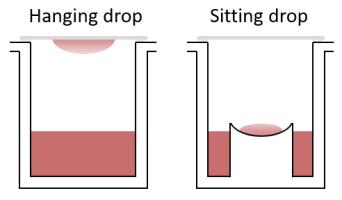Crystal Growth
Several methods are available for growing micro- or nanocrystals and preparing for a serial crystallography experiment.
Vapor diffusion crystallization

Vapor diffusion crystallization is a popular method for obtaining crystals of biological macromolecules. The protein solution is mixed with reagents that cause the proteins the crystallize, called the precipitant solution. This mixture is then placed—either as a hanging drop on a coverslip or as a sitting drop on a pedestal—over a reservoir that contains the undiluted precipitant solution. The hanging/sitting drop equilibrates with the reservoir solution through water vapor leaving the drop. This slowly increases the protein and reagent concentration in the drop, until supersaturation is reached, and crystals start to form.
Using a vapor diffusion setup, proteins can also be crystallized using supersaturation-controlled crystallization. By allowing the drop to dehydrate anywhere from 30 seconds to 30 minutes before sealing off the drop and crystallization well to increase the precipitant concentration in the drop. Allowing the drop to dehydrate for a longer time tends to cause more microcrystals.
Although vapor diffusion methods are often the first choice for screening crystallization conditions and growing large macromolecular crystals, they are less well suited for preparing serial crystallography samples. The hanging/sitting drop is usually only a few microliters in volume and several drops need to be combined to provide a sufficient volume with enough crystals for serial crystallography beamtime.
